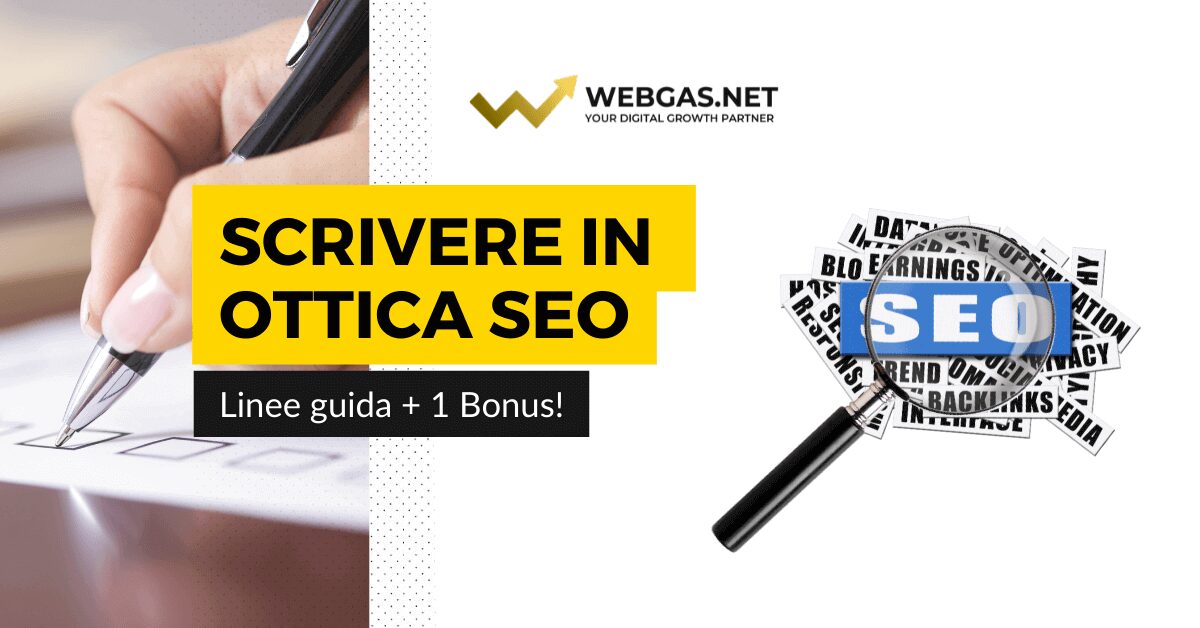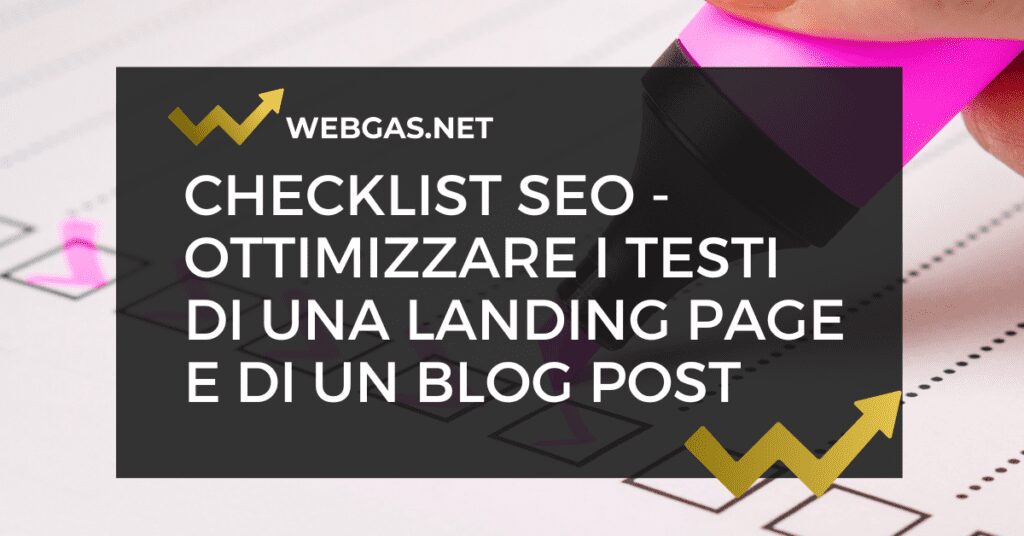INTRODUCTION
In this article, we will look together at the most important best practices (as a checklist) for writing SEO-friendly texts for a Landing or Blog Post according to one or more specific keywords.
The ‘pivotal goal is obviously to improve SEO scores for the purpose of increasing the likelihood ofour content appearing in higher SERP positions due to SEO friendly texts.
”The best place to hide a dead body is the second page of Google“
Why is an SEO checklist necessary?
- It ensures high quality content creation, as it allows the copywriter to pay attention to all the elements required by Google’s algorithm for the purpose of increasing the ranking of the content itself.
- Ensures compliance with Google guidelines. Since the well-known search engine has an extensive set of guidelines regarding content creation, following an appropriate checklist ensures that the copywriter complies with them.
- It prevents any significant errors in the writing of a piece of content that could negatively impact its ranking in the SERP.
Before we look at the technical SEO checklist to follow when writing and implementing content, let’s look at some preliminary points to be observed when designing it.

BEFORE WRITING THE CONTENT – WRITING IN SEO PERSPECTIVE
1) Define the objective of the content
It sounds trivial but it is not. Before writing from an SEO perspective, the copywriter must have clear in mind the main reason (why) why that content is needed. Having defined why that content is there and what it is aimed at, the writing process will be simpler and more coherent overall.
2) Define the recipient of the content and the message
Once we have defined the why of the content, we must also define the recipient of it ( who), i.e., the target subject to whom it is addressed, and the message (what) we want to deliver to it (the news, the main information that satisfies its search intent). The choice of target audience is also crucial in defining the writing style: for example, content aimed at experts on a certain topic may have more technical vocabulary than content aimed at ”beginners.”
3) Define search intent and related primary and secondary keywords (keywords)
Having defined the goal, target audience and message of the content, it is necessary to identify the user’s search intent (i.e., why a user performs a particular search on Google) and related keywords.
Four different types of research intent are identified in the literature:
- navigational (e.g., Apple site),
- informational (ex: better smartphones 2022),
- commercial (ex: iPhone vs. samsung),
- transactional (ex: buy iPhone 13).
For different search intentions, different types of ads correspond. For example, for a transactional search, the content must push the user toward conversion, which will certainly be easier than for an informational search user.
4) Analyze the search volume and competitiveness of primary and secondary keywords.
Once we have defined the keywords for which the content should be optimized, we need to understand how many times they are searched in a given time period (a month typically) and the level of competition that is present on them from our direct and indirect competitors.
Search volume helps us understand whether it is actually worth optimizing content for that keyword, while high competitiveness requires us to produce quality content that ranks higher and higher.

CONTENT WRITING – HOW TO WRITE IN SEO PERSPECTIVE
The Title
The Title (Headline) must contain the Main Keyword.
Example: main keyword = ”remarketing” ➝ content title = ‘‘Remarketing and Paid Advertising: Why is it critical in an online advertising strategy?”
Tags H2, H3 …
It is good practice to include the Main Keyword in the Heading (H2, H3 etc.) of the content.
Example: main keyword = ”remarketing” ➝” Remarketing Concept”
Secondary Keywords
In addition to the main keyword, include secondary keywords (LSI) in the content.
Secondary keywords (LSI) are keywords that are synonyms or related to the main keyword and help the search engine algorithm better understand the topic of the content created.
Example: main keyword = ”remarketing” ➝ secondary keyword:“Remarketing Facebook“
Keyword density
Main and Secondary Keywords must be present with a certain density ( keyword density ) within the paragraphs of the content.
You have to strike the right balance, inserting the primary and/or secondary keywords several times in the content text, while at the same time avoiding being lexically redundant.
The slug
The structure of the URL: the permalink must contain the main keyword.
Example: main keyword: ” remarketing ” ➝ permalink: ” https://webgas.net/it/remarketing-e-paid-advertising/” ”
Link Building
Inserting links (links) internal and external to our website related to content related to ours.
In this way we increase domain authority and improve SEO ranking. Such activity is also known as backlink.
It may be internal or external:
- internal backlink connects two different but related contents present within our website,
- the external backlink, on the other hand, links two different and related pieces of content located on two different websites.
Specifically, the latter requires that the link be set as ‘‘follow” so as to indicate to search engine bots to follow the link and highlight the correlation between the two pieces of content.
Tags and Categories
Insert tags and categories for each article. It is essential to insert specific tags and categories for the articles created within our blog in order to categorize and order certain topics and make it easier for search engine bots to crawl them.
Example: we have the following two articles: ”The Ultimate Guide to Pmax Campaigns in Google Ads” and ”The Different Types of Campaigns in Facebook Ads.”
Since they both deal with the same topic, i.e., digital advertising, you can think of placing both articles in the same category called ”digital advertising” and use the tag ”#googleads” for the first article and the tag ‘‘#facebookads” for the second.
Optimizing images
Insert images, name them by entering the main keyword and use the ALT TEXT attribute.
Within an article or landing page, the inclusion of images is essential to make the content visually appealing and more easily readable for the reader.
As Google crawls images, it becomes essential to name them by entering either the main keyword or a secondary keyword (keyword-principal. jpg or keyword-secondary.jpg), and the use of the ALTTEXT attribute (alternative text) through which we describe the uploaded image in a few words, which of course must be in line with the content, is also rewarded.
Meta Description
Insert meta description. While it no longer directly affects the SERP ranking of the content, the meta description cannot be missed within this SEO checklist as it can still indirectly affect it.
It is good practice to include the main keyword within it and a call to action, so as to stimulate the user to click and increase the CTR.
User Experience
Making reading easy and pleasant, improving the user experience.
One of the most important factors taken into consideration by the search engine is definitely the user experience within our site. Therefore, it is necessary to take all measures to make reading our content enjoyable.
It is therefore necessary in general to avoid blocks of text, insert bullet points, images and separators. The longer the user dwell time within the page they land on, the higher the SEO ranking of our content as Google will infer that that content is relevant and pertinent to users searching for that particular query.

CONCLUSIONS
The ‘content marketing activity in a brand’s digital strategy is often crucial in the pursuit of set goals and very often it requires the creation of content that is indexed within search engines, who care deeply about one thing: ensuring relevant and quality results for the users who use that search engine to find answers to their endless questions.
Therefore, it becomes essential for a copywriter to write SEO-oriented and to be well versed in the main rules of optimizing content for a search engine (SEO is in fact an acronym for Search Engine Optimization) so that win-win results can be achieved for all parties involved:
- The ‘company that, by placing quality SEO friendly content high on the search results page, gains visibility, traffic, awareness and conversions.
- The ‘searcher, who thanks to quality content satisfies his or her search intent by finding an answer to the question or doubt therein.
- The search engine itself, which by satisfying the user’s search intent, will most likely see that same user return to using the search engine at the time they have a need (i.e., always).
BONUS: SEO TEMPLATE CHECKLIST
To simplify the process of creating your own and to help you write from an SEO perspective, our Content Marketing Specialist Monica has created a very useful and practical SEO checklist template that you can use whenever you see fit.

The template is totally free and lists you step-by-step all the activities you need to write SEO-friendly and optimize your texts 100%.
Enter your email and you will receive it immediately in your inbox.
Happy content marketing to all!








